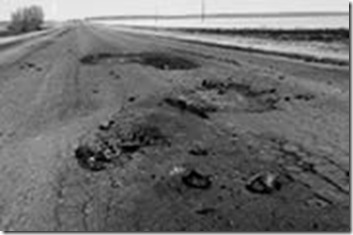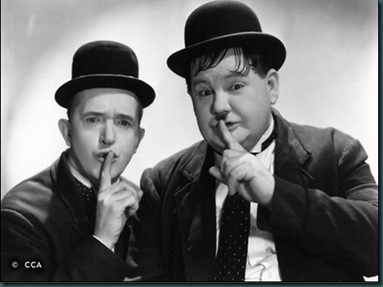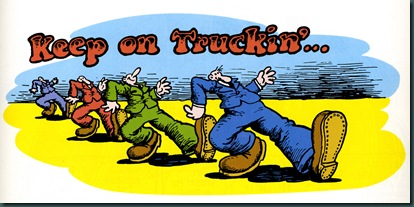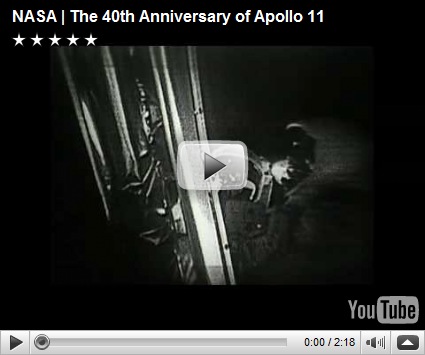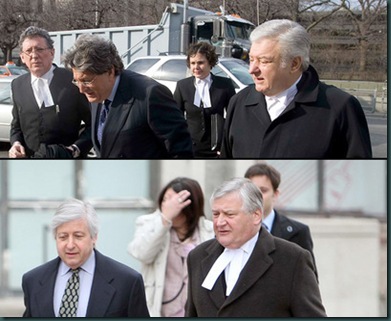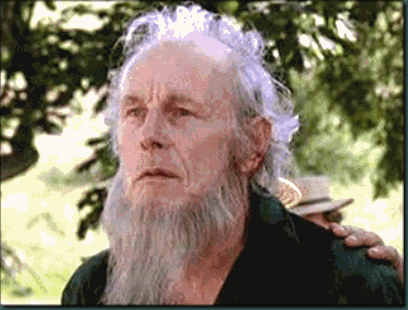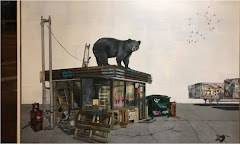Last month, I went on a kind of Quest, ferrying my 85 year old father back to the places where he (where we) come from. The trip took us to parts of Canada that never appear on television, to places unimportant to few but those who live there, meeting people whose life stories have never been much published or produced.
It was a journey that taught me a lot about my country, my people and myself. I’m still not sure what it all means. And like most of what I’ve written, I probably won’t discover what that is until some point in the writing. But from time to time over the next while, I’ll share some of these stories for whatever they may end up meaning to you.
I’ve been back in “The World” for a week now. “Back in the World” was a term Vietnam era soldiers used to describe leaving the war and returning to 1960’s America. But it seems as fitting today as it was back then.
In my current world of Toronto, the two big stories in the local papers were a month long garbage strike brought about by a struggle between Union and Management over worker benefits and a revelation that Paramedics were taking an additional 53 seconds to reach patients calling 911.
On the International scene, it was wall to wall coverage of the Obama Health Plan and a constant stream of invective against "Canadian-style Socialized Medicine”. Invective huffily dismissed by most in the Canadian media.
That 53 second story was of particular interest. Because I’d just spent time in a part of the country barely 20 clicks off Highway One – the blacktop ribbon that crosses the country from coast to coast and carries virtually all of the goods and services transported from East to West and vice versa. But despite their being in the immediate vicinity of what passes for modern civilization, it was a completely different world.
A world where anyone who calls 911 waits an hour or longer for help to come, if it is even able to reach them at all.
And, in an odd twist, this is the region of Canada that first championed universal medical care and where the political movement that spawned that concept of helping ones neighbors in time of need had turned its back on those it had once vowed to protect.
I remember being about 9 or 10, sitting with my parents as they listened to Tommy Douglas on the radio, vowing that if elected his CCF party would make sure that everyone got the medical care they needed no matter their income or position in society. My mother cried and hugged me. I was very sick as a kid and what Tommy Douglas was doing meant my family could afford to keep me alive.
At the time, we lived in the South West corner of Saskatchewan, along a winding gravel road called Highway 32. There was a hospital at each end in Swift Current and Leader and one in the middle at Cabri. I’d spent time in them all.
A dozen towns six to eight miles apart were connected by that highway, each with their own rows of grain elevators and some with the garages, stores and banks that people in the other towns used the highway to reach. It wasn’t unusual to spend a Saturday going to the dentist in one, the Co-op store in another and the movie theatre in a third.
In an area where neighbors could be miles apart and 90% of the land had been turned into endless fields of wheat and grasslands for cattle, the 3-4000 people who lived near Highway 32 got used to all going to the same dentist in one town or using the same bank in another, aware that there weren’t enough of them for everything to be everywhere or even “convenient”. But they were close to some things and had to go a little farther for others – and the road they needed to take was pretty good.
About 5 years ago, that all changed.
The number of people stayed the same (even grew a little) and despite some of the towns declining, the economy around them prospered and diversified.
Farmers were now growing more crops, including healthier oil bearing Canola and even Lentils. They ranched Buffalo and Elk as well as cattle. Some raised deer to serve the Asian antler and velvet markets. Meanwhile, geologists discovered their farms lay on top of some of the richest potash and natural gas fields in the world.
Sleepy one street villages were replaced by gas plants that dwarfed the original owners of their place names. In 2005, the little towns along Highway 32 contributed $263 Million to the Province of Saskatchewan in Natural Gas royalties alone.
Yet, the government allowed Highway 32 to fall into disrepair. In 2005, it was estimated that it would take $12 Million to put the road back in working order.
Four years later, that road still isn’t fixed.
All along its length you hear story after story of ambulances bottoming out in potholes during an emergency run and breaking an axle; of buses careening into ditches in the rain; of trucks overturning and blocking all traffic for hours because tow trucks can’t navigate the highway to clear the wreckage.
As a result, ambulances don’t run on Highway 32 anymore. Even when they reached victims in time, it was impossible to provide any care during the bumpy ride back to the hospital.
The buses have stopped. Basic goods don’t get delivered unless store owners truck them in at their own risk and additional expense. People have stopped making trips to the other towns along the highway’s route because they’re not sure if they’ll make it, let alone make it home.
On one rainy afternoon, it took me almost an hour to cover 10 clicks of solid mud, sliding dangerously close to steep ditches or slamming into potholes almost deep enough to swallow the car.
I met a bank teller who can’t get to work some days, meaning the two employee bank doesn’t open. I bought a coke from a kid who couldn’t count the number of days the school bus hadn’t been able to either pick him up or get him to school.
I pried stones out of the brake shoes with the help of an oil roughneck who deals with that kind of screaming every day and says his average windshield lasts two months because of all the stone hits.
I sat with a retired farmer who described the night his wife had a heart attack and he did CPR on her for an hour and pushed Nitro tablets under her tongue while a 911 operator told him to do nothing until the paramedics arrived.
The next day the doctor told him that it was he and not the medical system that had saved her life.
How did this happen in a Province making so much money its new nickname is “Saskaboom!”?
According to the locals, they made a mistake. They stopped voting NDP and were punished for sending somebody else to Regina to represent them.
That made a lot of sense to me, for I’ve seen how the party of Tommy Douglas’ compassionate revolution has devolved to defending union thugs whose sense of entitlement takes precedent over retirees in walkers trying to carry a bag of adult diapers past the picket line at a temporary garbage dump.
In 1960, the socialist government of Tommy Douglas airlifted doctors into Saskatchewan to break a strike by the medical profession to save its population.
In 1990, the socialist government of Bob Rae put its population at risk by reducing the number of doctors training in Ontario universities to save money.
Somewhere along the way, the party that cared became one where you only mattered if you were one of them.
The remarkable “Sand Hills Museum” in Sceptre, exhibits a poster from 1960 detailing the new Medicare plan “$24/person, $48/family” yet sometimes only sees one tourist a day because of the road.
In 2007, the party that had been founded on rural discontent only won seats in a few inner cities and the government changed with Premier Brad Wall’s Saskatchewan party (an offspring of the right wing Reform movement) coming to power. And plans were immediately made to put Highway 32 back together again.
Oddly, although gas revenues from the area are now higher than they’ve ever been and the trainloads of Lentils and velvet are making us new friends all over Asia, the repairs to the highway proceed at a snail’s pace.
It seems the new boss suddenly has other “priorities”.
From personal observation, it would appear that Premier Wall’s most pressing priority is building as many casinos as he can to ensure that none of those gas and potash riches get beyond his borders.
There are new casinos everywhere in the Province. I suggested the locals might actual get the highway fixed if somebody called the Premier’s office and complained about being unable to get to Swift Current’s shiny new “Living Sky” Casino so they could have their pockets vacuumed.
But seriously, how is it possible that people living in one of the richest regions of one of the world’s richest countries can’t be certain an ambulance will arrive in time to save a pensioner who’s had a heart attack, a farmer trapped under an overturned tractor, or a child drowning in a community pool?
Cities in the country facing bankruptcy can still get help to their citizens in under 3 minutes. In Brad Wall’s cash flush Saskatchewan, help might never get there.
A few years ago, people along Highway 32 started fighting back. They sold bumper stickers, a very popular “Pothole Calendar” and a website with the full story (and video) at www.highway32.ca.
They’re getting somewhere, but they could use more help.
If you feel your fellow Canadians should have the same access to health care as you do or simply that people elected to public office are there to serve all the people and not just those who vote for them, pay a visit to the site and kick in your two cents (either literally or figuratively). A few thousand people you’ve never met will be forever in your debt.
And do that soon, because if the tales of Medical need along Highway 32 ever get across the border, we’re in for a week of hysteria on Fox News, more Canada bashing and a lot of Americans who might end up not getting the reformed Medical system they so desperately need.
You might also write a letter to Saskatchewan Premier Brad Wall and ask why a Province that plans to build nuclear power plants and space age wind farms can’t fix a short stretch of highway.
In my letter, I’m also going to mention that all the tourists I talked to thought the downtown of his capital city was a “shithole” with nothing to do or see.
Unless you wanted to visit the casino.

